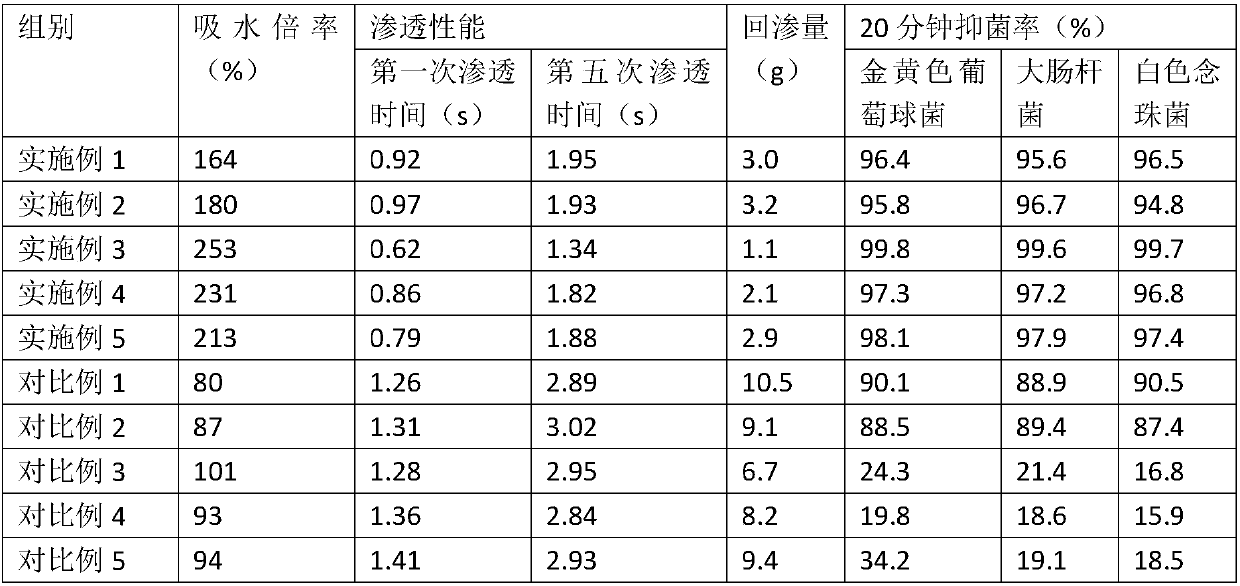Dry and clean high-adsorption hot-air non-woven fabric
A technology of hot air non-woven fabric and spinning oil, which is used in non-woven fabrics, textiles and papermaking, fiber chemical characteristics, etc., can solve the problem of rough and poor surface material of sanitary napkins, skin vulnerable to damage or infection, and urine infiltration. Slow speed and other problems, to achieve the effect of excellent antibacterial function, excellent antibacterial property and good comfort
- Summary
- Abstract
- Description
- Claims
- Application Information
AI Technical Summary
Problems solved by technology
Method used
Image
Examples
Embodiment 1
[0024] A kind of air-through non-woven fabric, the raw material and raw material weight percentage of this air-through non-woven fabric are:
[0025] 50 parts of ES composite fiber, 40 parts of superabsorbent fiber (purchased from Nantong Jiangchao Textile Technology Co., Ltd.), 30 parts of silk fiber (purchased from Ni’s silk spinning factory in Wujiang City), chitin fiber (purchased from Qingdao Xinling Lixiu product factory) 20 copies;
[0026] Among them, the raw material composition of ES composite fiber is:
[0027] 0.001 part of nano-silver, 30 parts of PE (purchased from Xinjiang Dushanzi Petrochemical General Plant), 30 parts of PP (purchased from Liaoyang Petrochemical Fiber Company); nano-silver is doped in the cortex PE and core PP in equal amounts;
[0028] The percentage by weight of the spinning finish in the ES composite fiber preparation process consists of:
[0029] 10% potassium dodecylphosphate (purchased from Changsha Jianglong Chemical Technology Co., L...
Embodiment 2
[0032] A kind of air-through non-woven fabric, the source of each raw material is the same as in Example 1, the raw materials and raw material weight percentages of the air-through non-woven fabric are: 40 parts of ES composite fiber, 20 parts of super absorbent fiber, 10 parts of silk fiber, and 10 parts of chitin fiber ;
[0033] Among them, the raw material composition of the ES composite fiber is: 0.005 parts of nano-silver, 50 parts of PE, and 50 parts of PP; nano-silver is doped in equal amounts in the skin layer PE and core layer PP;
[0034] The percentage by weight of the spinning finish in the ES composite fiber preparation process consists of: 15% alkyl dodecyl phosphate potassium salt, 35% lemon extract (Xi'an Yuansen Biotechnology Co., Ltd.), 0.1% EDTA- 2Na, make up to 100% with deionized water.
[0035] The preparation method is the same as in Example 1.
Embodiment 3
[0037] A kind of air-through non-woven fabric, the source of each raw material is the same as that in Example 1. The raw materials and raw material weight percentages of the air-through non-woven fabric are: 50 parts of ES composite fiber, 30 parts of superabsorbent fiber, 10 parts of silk fiber, and 10 parts of chitin fiber ;
[0038] Among them, the raw material composition of the ES composite fiber is: 0.004 parts of nano-silver, 50 parts of PE, and 50 parts of PP; nano-silver is doped in the skin layer PE and core layer PP in equal amounts;
[0039] The percentage by weight of the spinning oil in the ES composite fiber preparation process consists of: 12% potassium dodecylphosphate, 30% rose extract (Xi'an Yuansen Biotechnology Co., Ltd.), 0.05% EDTA -2Na, make up to 100% with deionized water.
[0040] The preparation method is the same as in Example 1.
PUM
 Login to View More
Login to View More Abstract
Description
Claims
Application Information
 Login to View More
Login to View More - R&D
- Intellectual Property
- Life Sciences
- Materials
- Tech Scout
- Unparalleled Data Quality
- Higher Quality Content
- 60% Fewer Hallucinations
Browse by: Latest US Patents, China's latest patents, Technical Efficacy Thesaurus, Application Domain, Technology Topic, Popular Technical Reports.
© 2025 PatSnap. All rights reserved.Legal|Privacy policy|Modern Slavery Act Transparency Statement|Sitemap|About US| Contact US: help@patsnap.com

